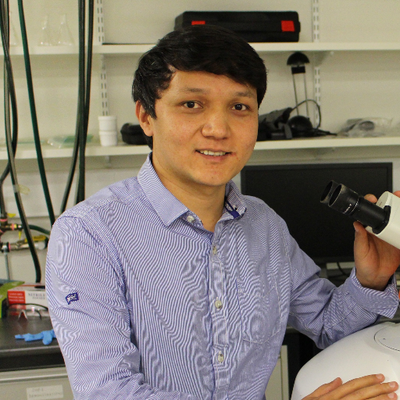Facile Fabrication of Plasmonic Nanostructures for Surface Enhanced Vibrational Spectroscopy
Date:
Talk at NanoTR-16, Ankara, Turkey
Abstract: Detection and analysis of even a minute concentration of molecules is important in various fields such as environmental monitoring, food quality control, and clinical analysis. One of the convenient and non-destructive techniques that can be used for such purposes is vibrational spectroscopy, due to unique vibrational fingerprint of molecules. However, the detection capability of conventional spectroscopic techniques such as Fourier transform infrared (FTIR) and Raman spectroscopy is limited to due to weak signal. Fortunately, signals of analyte molecules placed close to plasmonic nanostructures can be enhanced millions of times, due to the strong confinement of light. These results in enhanced absorption of IR light and strong Raman scattering, as used in surface enhanced IR absorption (SEIRA) and SERS techniques.1 Coinage metals (Au, Ag, Cu) can support surface plasmons, which can be confined to surfaces to achieve strong localized surface plasmon resonances (LSPR) by engineering nanostructures made of those metals. Plasmonic nanoparticles can be conveniently synthesized via colloidal chemistry, though structural (size, shape, etc.) control is difficult, especially so for high aspect ratio particles that needed for SEIRA. On the other hand, precise nanostructures can be prepared using conventional lithographic techniques such as e-beam lithography, laser lithography, etc. However, these techniques involve complex processes, and require specialized facilities and expensive equipment, hindering development of novel plasmonic nanostructures for surface enhanced vibrational spectroscopy applications. In this study, we explore two convenient approaches that can be used to fabricate plasmonic nanostructures, focusing on their applications in SEIRA. In the first approach, we employ electrohydrodynamic jet printing (e-Jet) to print arrays of narrow (~200 nm) polymer brushes that is a few μm long, followed by immobilizing commercial gold nanoparticles (NPs) or growing them in situ.2 This results in plasmonic nanoantenna arrays whose LSPR can be tuned to be in the mid IR region (3-20 μm) so that traditional FTIR instruments can be used to measure SEIRA spectroscopy of various molecules. It turns out this is an effective and low-cost approach to fabricate substrates for SEIRA, especially for prototyping purposes. Furthermore, enhancement and quality factor of the plasmonic nanoantenna is compared against nanoantenna’s fabricated using traditional lithographic techniques, as well as against finite difference time domain simulations (FDTD) performed using open-source python package MEEP.3 In a second approach, we utilize dewetting to fabricate micron-scale islands of polymers, followed by immobilizing Au NPs. The results indicate that both structural and plasmonic effect led to patterns in the visible range, as well as multiple LSPR bands in the mid IR region. Furthermore, it is observed that the coupling between molecular vibration of the underlying polymer and the LSPR results in Fano type line shape in the SERIA spectra.4 These plasmonic substrates can used for SEIRA as well as for SERS applications.
Acknowledgement: “This project receives funding from the European Union’s Horizon 2020 research and innovation programme under the Marie Skłodowska-Curie grant agreement No 801509”. Mahmut Ruzi like to thank TÜBİTAK for support via 2236 project (121C048) and the support of Erciyes University BAP is also acknowledged.
References: [1] Altug, H.; Oh, S.-H.; Maier, S. A.; Homola, J. Advances and Applications of Nanophotonic Biosensors. Nat. Nanotechnol. 2022, 17 (1), 5–16. https://doi.org/10.1038/s41565-021-01045-5 [2] Kiremitler, N. B.; Torun, I.; Altintas, Y.; Patarroyo, J.; Demir, H. V.; Puntes, V. F.; Mutlugun, E.; Onses, M. S. Writing Chemical Patterns Using Electrospun Fibers as Nanoscale Inkpots for Directed Assembly of Colloidal Nanocrystals. Nanoscale 2020, 12 [3] Oskooi, A. F.; Roundy, D.; Ibanescu, M.; Bermel, P.; Joannopoulos, J. D.; Johnson, S. G. Meep: A Flexible Free- Software Package for Electromagnetic Simulations by the FDTD Method. Computer Physics Communications 2010, 181 (3), 687–702. https://doi.org/10. [4] Giannini, V.; Francescato, Y.; Amrania, H.; Phillips, C. C.; Maier, S. A. Fano Resonances in Nanoscale Plasmonic Systems: A Parameter-Free Modeling Approach. Nano Lett. 2011, 11 (7), 2835–2840. https://doi.org/10.1021/nl201207n
